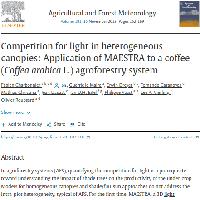Resumen
-
In agroforestry systems (AFS), quantifying the competition for light is a prerequisite toward understanding the impact of shade trees on the productivity of the under-crop. Models for homogeneous canopies and shade/full-sun approaches do not address the intra-plot heterogeneity, typical of AFS. For the first time, MAESTRA, a 3D light absorption model, was fully parameterized in a heterogeneous 2-canopy layers AFS. We quantified competition for photosynthetic photon flux density (Q) between shade trees (Erythrina poepiggiana) and coffee (Coffea arabica), with a spatial resolution from the plant to the plot (2.7 ha) and a temporal resolution from half-hour to one full year. The predicted transmittance through the 2-canopy layers was verified against field measurements. The goodness of fit (R2 > 0.75, RRMSE < 26%) was comparable to the predictions from 10 other studies using 3D light models and mostly verified in one-layered systems (mean R2 = 0.89 and mean RRMSE = 17%). Maps of absorbed Q showed that despite their low density in the plot (5.2 trees ha−1), the tall Erythrina trees reduced Q available for the coffee layer by 14% annually. Annual pruning of the oldest unproductive coffee resprouts maintained a large horizontal heterogeneity in coffee LAI, with direct impact on the Q absorption map. This management practice had a strong impact on seasonal variations of absorbed Q by the coffee canopy. We proposed also a simple approach to estimate Q absorbed yearly by the coffee plants in AFS of variable tree density, requiring only few measurements in the field. An extrapolation indicated that the amount of Q absorbed by the coffee canopy would display a negative exponential relationship (k = −0.34) when increasing shade tree density (from nil to 29 trees ha−1). The estimated k was similar to the shade tree extinction coefficient of diffuse radiation measured with a plant canopy analyzer. We showed that the presence of shade trees tends to reverse the diurnal time course of the fraction of Qa when compared to a plantation in the open.
Overall, MAESTRA proved to successfully unlock the question of intra-plot heterogeneity for light absorption and to provide defensible light budgets as a continuous and mapped covariable, a crucial step for many field experimentations.
